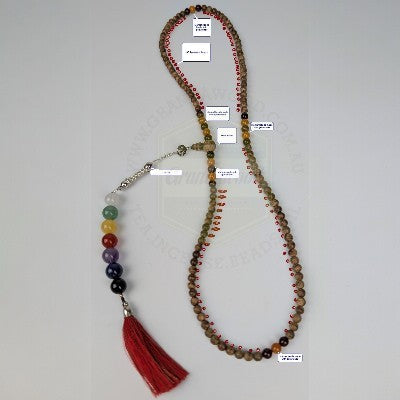
什么是念珠?了解念珠的用途和好处
一月 03, 2025 1 读
目录: [隐藏]
什么是念珠?

念珠,也简称为玛拉,不仅仅是串珠;它们是弥合物质与精神之间鸿沟的深刻精神工具。念珠传统上在印度和其他精神中心制作,在各种文化和宗教中都有使用,包括印度教、佛教和藏传佛教。它们是冥想的支柱、精神成长的象征,也是与内心自我联系的一种方式。在本文中,我们将探索念珠的复杂性,从其成分和材料到其文化意义和现代应用。
念珠的意义和历史
念珠的传统可以追溯到几千年前,起源于佛教、印度教和其他精神传统。用念珠来计算祈祷或咒语的概念一直是基督教和伊斯兰教等各种宗教的核心实践。
古代念珠通常由檀香、菩提子、沉香珠或宝石等神圣材料制成,人们认为每种材料都具有独特的精神属性。这些念珠有助于集中注意力、增强呼吸意识并鼓励人们重复念诵神圣的咒语。
沉香珠在精神修炼中享有崇高的地位。沉香取自沉香树的树脂心材,以其浓郁的木质香气而闻名,常与宁静和增强的精神意识联系在一起。沉香珠的稀有性和重要性使它们受到冥想修炼者和收藏家的追捧。
念珠的组成部分:上师珠
传统的念珠由 108 颗珠子、一颗上师珠(念珠中最大的珠子)、一个流苏和一根绳子组成。这 108 颗珠子通常被称为计数珠,用于记录冥想时念诵的咒语或祈祷词的数量。
上师珠

它代表着老师或精神导师。它还提醒人们精神之旅和沿途收到的教诲。上师珠位于念珠的末端,是冥想时念诵真言的起点和终点。它象征着对传授精神智慧和指导的人的尊重和认可,有助于深化使用者的冥想练习和精神成长。这颗珠子也是对生命周期性和精神课程的沉思点,因为修行者不会越过上师珠,而是改变方向继续冥想或祈祷。
流苏

流苏是可选的,通常附在上师珠上,象征着开悟和莲花的纯洁。它还代表着修行者与神之间的团结和联系。
流苏象征着莲花,代表着纯洁和超越人类欲望的精神能力。
字符串

将珠子绑在一起的绳子代表着生命的相互联系、统一以及存在的永恒本质。
梵语“mala”意为“花环”,象征着其装饰性但又具有深远的精神意义。念珠用于在冥想时集中注意力,作为人们意图和祈祷的触觉提醒。
念珠的象征意义和能量影响
念珠的每个元素都承载着精神和能量的意义。
-
上师珠:代表智慧和指导。
-
流苏:象征启蒙和纯洁。
-
珠子:吸收咒语的振动,增强其能量。
念珠不仅仅是一种配饰;它还是一种精神能量的宝库,承载着佩戴者的意图和祈祷。
用念珠设定意图
在开始冥想练习之前,设定意图至关重要。您的意图可以是:
-
特定的单词或短语(例如“和平”或“爱”)
-
个人肯定
-
提醒大家留在现场
根据其精神属性选择合适的珠子可以增强您在练习过程中保持和专注于意图的能力。如果您追求平静和提高意识,沉香珠可能是您冥想之旅的完美伴侣。
念珠所用的材料
制作念珠的材料不是任意选择的;每种材料都带有特定的能量和象征意义。
木珠
-
檀香:檀香以其镇静的香味而闻名,人们相信檀香可以增强精神能量并促进平静。
-
罗勒木:罗勒木在印度教中备受尊崇,象征着虔诚和纯洁。
菩提子种子

菩提子源自神圣的菩提子树,被认为是灵性治疗的强大工具。人们相信这些种子可以协调能量、减轻压力并促进头脑清醒。
宝石

念珠中经常会镶嵌紫水晶、玫瑰石英和绿松石等半宝石。每颗宝石都有独特的治疗功效,因此修行者可以选择符合自己意图的念珠。
沉香木
沉香木因其芳香品质而备受推崇,可增强冥想时的专注力。沉香木是许多精神传统中的神圣材料。沉香木与念珠制作有着深厚的联系。沉香珠以其深沉、共鸣的香气和用于制作高品质香而闻名,它不仅是冥想的工具,而且在许多精神传统中被视为神圣之物。沉香木融入念珠中,可增强精神体验,让使用者脚踏实地,并增强冥想练习的认知益处。
念珠设计的变化
念珠有多种设计,可以满足不同的精神和个人需求。
珠子数量变化
虽然 108 颗珠子是传统的念珠,但为了缩短冥想时间或方便携带,通常使用 27 颗或 54 颗珠子的念珠。
标记珠
一些念珠上间隔放置有标记珠,以帮助练习者在长时间的冥想过程中追踪进度。
手链和项链
念珠手链由较少的珠子制成,适合日常佩戴,可以让佩戴者全天携带自己的意图和能量。
念珠背后的科学
-
事实证明,念珠对精神、心理和生理健康有积极的影响。
-
重复念诵咒语和触摸念珠可以增强注意力并减轻压力。
-
定期练习冥想可以带来多种心理益处,包括更加平静和提高意识。
念珠的益处
-
念珠对于身体、心灵和精神有诸多强大的益处。
-
它们可以提高咒语冥想时的注意力,提供一种有效的咒语计数方法,并传递治疗力量。
-
经常使用念珠可以增强注意力,提高精神意识,并利用强大的治疗能量。
-
咒语冥想的有效性
一项系统评价发现,以咒语为基础的冥想(例如,重复类似于使用念珠练习的咒语)可显著减轻焦虑、抑郁和压力,并改善与心理健康相关的生活质量( https://doi.org/10.3390/ijerph19063380 )
-
动态冥想与心理健康
研究表明,动态冥想可以改善人格整合、自主性和环境掌控力,表明其对增强整体心理健康有效( https://doi.org/10.1007/s10943-015-0082-x )
-
正念冥想的神经科学
研究表明,冥想练习会影响与减轻压力和改善健康相关的大脑网络,支持集中和重复冥想练习的益处( https://doi.org/10.1038/nrn3916 )
-
冥想和心理压力
一项系统评价和荟萃分析发现,有中等证据表明,正念冥想课程可以减轻焦虑、抑郁和压力相关的健康问题( https://doi.org/10.1001/jamainternmed.2013.13018 )
-
非临床人群中的咒语冥想
另一项研究显示,咒语冥想对心理健康有轻微到中等程度的有益影响,使其成为一种有效的压力和焦虑管理策略( https://doi.org/10.1016/j.eujim.2018.09.010 )
如何在冥想练习中使用念珠
在冥想过程中,初学者的头脑经常会感到困惑。为了帮助他集中注意力,引入了念珠。
咒语是梵语中的一种神圣话语、音节、单词或词组,被认为具有心理和精神力量。咒语练习在各种精神传统中都很常见,包括印度教和佛教,在这些传统中,咒语被反复吟诵,作为冥想或虔诚活动的一部分。人们认为,重复咒语有助于集中注意力,达到更高的精神意识状态,并与神建立联系。咒语可以是简单的声音,例如“Om”或“Amitabah”(在净土宗中),也可以更长更复杂,由在各自传统中有意义的短语或祈祷组成。
念珠用于冥想和精神修炼,帮助重复咒语或祈祷。
念诵咒语或祈祷时,念珠在手指间移动。念珠可作为标记,记录念诵的次数。念珠可增强您的注意力。
以下是 5 个简单步骤
-
选择舒适的座位:坐在安静、舒适且不会被打扰的地方。
-
选择咒语:选择能引起您共鸣的咒语。例如“Om”、“So Hum”、“Amitabah”、“A mi tu fuo”或与您的信仰相符的祈祷词。
-
从上师珠开始:用拇指和食指握住念珠,从上师珠开始。
-
移动珠子:每念一次咒语,就将一颗珠子滑到手指之间。
或者用拇指移动每个珠子,一些教练或老师建议避免使用食指,因为传统上食指与自我相关。
-
在 Guru Bead 处暂停:当你到达 Guru Bead 时,反思,然后反方向继续(到达 Guru Bead 后朝相反方向移动)。
-
呼吸:计算每次重复时,专注于你的呼吸、咒语或意图。
念珠的能量和心理影响
-
人们相信念珠能够与修行者的能量场进行动态互动。
-
每颗珠子都可视为吸收与其一起使用的咒语或意图的振动。
-
念珠可用来增强集体冥想练习的集体能量。
马拉使用的文化差异
几个世纪以来,念珠一直受到各种文化和精神习俗的珍视,每种传统都赋予了念珠独特的意义和使用方法。在印度教中,念珠是念诵咒语和祈祷的重要部分,通常由檀香、圣罗勒和菩提子等材料制成。这些珠子通常戴在右手的食指上,用拇指移动,象征着精神之旅。
在佛教中,念珠也有类似的用途,但用于计数呼吸和念诵祷文。在藏传佛教中,这些珠子通常用于深奥的修行,并被保密,反映了与精神之路的深厚个人联系。藏传念珠使用的材料通常包括菩提种子和骨头,每种材料都具有深刻的象征意义。
日本佛教念珠,又称“ojuzu”或“o-nenju”,其用途因教派而异。这些念珠是精神修行的重要组成部分,有助于冥想和祈祷。念珠在不同文化中的使用差异凸显了其普遍的吸引力和适应性,使其成为不同传统中实现精神成长和内心平静的有力工具。
念珠的保养和清洁
-
念珠需要物理护理和清洁才能保持其精神意义。
-
我们应该以尊敬和感激的态度对待它们。
-
可以定期清洗念珠以保持其精神意义。
选择合适的念珠
-
选择念珠的最好方法是遵从你的心意并倾听你内心的声音。
-
考虑一下念珠的用途及其用途。
-
考虑一下念珠的颜色、能量和材质,以及它们与您的预期用途的关系。
念珠的历史和意义
- 起源与发展:念珠的使用被认为起源于古印度。早期的参考资料表明,印度圣贤使用由神圣的种子和石头制成的念珠来记录他们的祈祷和冥想练习。后来,这一概念随着佛教的传播而传播到亚洲其他地区,包括西藏、中国和日本,在那里它被接受并适应当地的精神实践。
- 文化和宗教意义:在印度教中,念珠通常由 108 颗珠子组成,这在许多东方宗教中是一个神圣的数字。每颗珠子代表冥想或祈祷时重复念诵的咒语。念珠从一端开始,修行者绕一圈,最后到达被称为“上师珠”的大珠子,这表示完成一轮念诵。
- 在佛教中,念珠的用途类似,但也可以提醒人们生命无常。藏传佛教徒可能会使用由不同材料制成的念珠,例如木头、种子或宝石,人们认为每种材料都能赋予特定的能量。例如,用菩提子或莲花籽制成的珠子被认为特别吉祥。
- 变化和用途:除了宗教用途外,念珠在各种文化中也被用作“烦恼珠”,用于放松或缓解焦虑。这种世俗用途凸显了念珠作为正念和集中注意力工具的多功能性。
- 在现代,念珠已超越了传统范畴,在当代精神修行中占有一席之地。它们经常用于瑜伽和冥想课程,帮助保持专注和念诵流畅。念珠有助于记录咒语或呼吸的重复次数,让修行者可以更深入地冥想,而不会分心于计数。
- 精神工具和象征:归根结底,念珠不仅仅是计数工具。它们对佩戴者来说具有个人和精神意义。每串念珠都可以看作是一次个人信仰、纪律和冥想之旅,随着使用而变得更加强大和重要。作为一种精神工具,念珠可以帮助深化冥想并培养与神的更紧密联系,不断提醒人们的精神承诺和愿望。
- 念珠在修行中的历史和意义深远,是物质与精神、个体与无限之间的桥梁。无论是在日常修行中还是在特殊的宗教仪式中使用,念珠仍然是世界各地许多社区精神生活的重要组成部分。
念珠的现代用途和流行程度
念珠已从古老的精神工具演变为用于各种精神和世俗背景的现代工具。它们正融入现代生活方式和健康实践中。它们还常用于瑜伽练习,以增强精神专注力和正念。念珠已成为健康中心、瑜伽馆和整体健康实践中的特色。
-
念珠是精神成长和冥想练习的有力工具。
-
它们在精神实践方面具有丰富的历史和意义。
-
通过了解念珠的用途和好处,您可以加深冥想练习并增强精神之旅。
就是这样
在 Grandawood,我们是沉香木种植者。
沉香木在制作念珠或念珠方面发挥着重要作用,为冥想练习增添了独特的精神和芳香维度。沉香木以其浓郁、回旋的香气和在各种文化和精神传统中的崇高地位而闻名,它不仅因为其香味而备受推崇,还因为其精神益处而备受推崇。
人们认为,沉香珠用于念珠中可以增强冥想体验。沉香浓郁的木质香味被认为可以促进放松和集中注意力,有助于加深冥想状态并使练习更有效。这种香味在旨在使头脑清晰和心神平静的练习中尤其有用。
此外,沉香还具有多种形而上学特性。人们通常认为沉香具有保护特性,可以保护佩戴者免受负能量的侵害,并培养情感和精神上的幸福感。因此,沉香念珠不仅是冥想的工具,也是保护和个人圣洁的护身符。
沉香木在念珠中的使用也使念珠使用者与古老的传统联系起来,因为这种材料几个世纪以来一直用于各种文化的神圣仪式和香火中,包括印度教、佛教和伊斯兰教。这种历史和文化意义为念珠增添了多层含义,丰富了使用者的精神之旅,并将他们与过去精神实践的古老智慧联系起来。

总而言之,沉香通过赋予念珠独特的香味、保护特性以及深厚的文化和精神根源来增强念珠的效果,使每颗念珠都成为追求精神成长和冥想修行的强大盟友。
点击 此处查看我们的念珠和沉香念珠
通过将念珠融入您的日常生活,您可以培养一种更加专注和有目的的生活方式,并在每一步都与您的精神之旅保持联系。
关于念珠的常见问题
-
我可以一直佩戴念珠吗?可以,许多人佩戴念珠项链或手腕念珠作为精神配饰并提醒自己修行。如果您的念珠含有木珠,请避免接触水。
-
念珠的正确握法是什么?传统上,念珠被戴在中指上,用拇指计数,有人建议在移动念珠时避免使用食指。在印度教和佛教哲学中,食指通常与自我或自负有关。它也代表风(Vayu) ,与木星(Guru)有关,象征着权威和指导。然而,它也与指责、控制或责备有关——这些特征在精神修炼中是被禁止的。
-
如果我的念珠断了怎么办?念珠断了被视为精神成长的标志,表明也许是时候设定新的目标了。
-
不同的材料有不同的能量吗?是的!宝石、木材和水晶都具有独特的特性,可以影响您的冥想。例如,沉香珠因其能够带来平静和存在感而闻名。
-
我可以在瑜伽中使用念珠吗?当然可以!许多瑜伽修行者会佩戴念珠来专注于呼吸、念诵咒语和正念。
留个言
张贴前管理员会先审核您的留言




